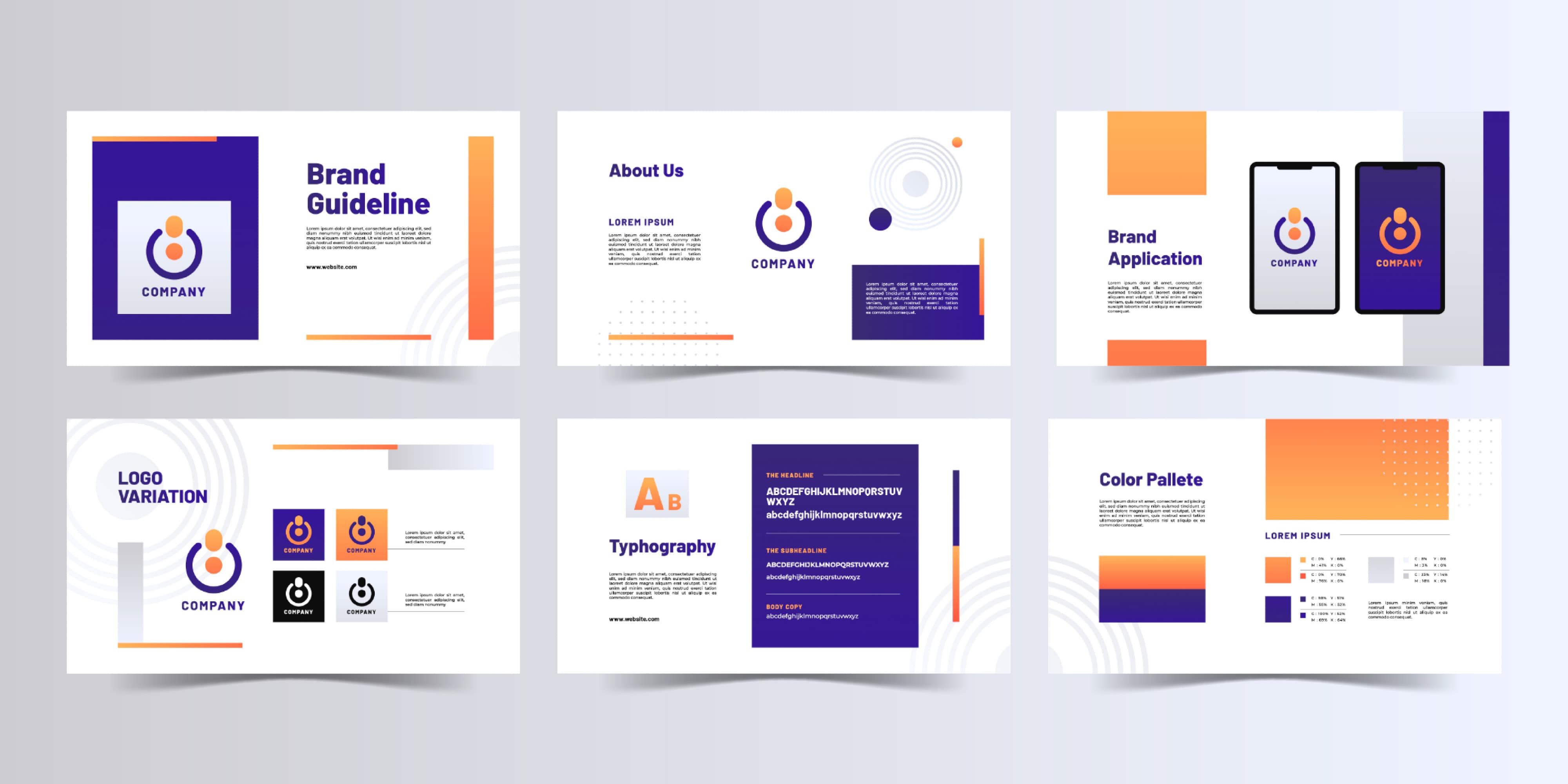Your brand is your company’s identity, your trademark, and your reputation. A strong brand differentiates your business from your competitors and builds customer loyalty. But how do you ensure that your brand remains consistent across all marketing materials, digital platforms, and internal communications? This is where a brand book or style guide comes into play. In this blog post, we will guide you through the process of creating a brand book that truly represents your business and help you avoid common mistakes along the way.

What is a Brand Book?
A brand book, or brand style guide, is a comprehensive document that sets the rules and guidelines for presenting a brand across various platforms. It provides a cohesive framework for all brand-related decisions, from visual aesthetics to voice and tone. A brand book, acts as the bible for your brand. It is the go-to resource to ensure consistency across all platforms and media.
The Importance of a Brand Book
A brand book is like a guidebook for your business's identity. It helps keep everything looking the same across different marketing places, making your brand easier to recognise. It includes not just your logo or colours, but also what your company stands for and its mission.
This helps your message connect better with your audience. It also makes it easier and quicker for your team to create new marketing materials. Plus, it helps everyone work towards the same goals. A brand book is a key tool that helps your brand stand out and be remembered.
Essential Brand Elements
Before we dive into the key elements of a brand book, it’s important to have a clear understanding of your brand’s essentials. These elements lay the foundations for your brand and provide direction for creating a brand book that accurately reflects your brand identity. Businesses should create their brand books only after defining what makes them distinctive. That includes:
- Brand USP: Unique selling proposition is your brand's distinctive edge in the competitive market. It represents the unique value you offer, which sets you apart from competitors. It's a persuasive reason for customers choosing you over others.
- Vision and Core Values: These represent the pillars on which your brand stands. They define its values, ideals, and guiding principles.
- Brand Mission: A concise statement that captures the raison d'être of your brand—its purpose, motivation, and objectives.
- Brand Persona: Think of this as the character or personality of your brand. Is it casual and friendly? Authoritative and professional? This persona helps shape the interactions your brand has with its audience.
- Target Audience: Clearly define who you're speaking to. Understand their needs, preferences, and behaviors to make your brand more relatable and appealing.
Ultimate Guide to Building an Authentic Brand Platform

Brand Book Anatomy
A brand book or style guide is a comprehensive document that outlines all aspects of your brand. It typically includes three main components:
- About Section
- Visual Guidelines
- Communication Guidelines
About section contains details and brief introduction to the brand’s history, vision, mission, and values. This section delves into the heart and soul of the brand. It tells the brand's story, painting a picture of its inception, evolution, and milestones achieved along the way. It serves as a reminder of the brand's foundations and drives the future direction, helping stakeholders to resonate with the brand on a deeper level.
Visual Guidelines section outlines the aesthetic representation of the brand, including logos, colours, typography, and imagery. A brand's visual identity plays a pivotal role in how it is perceived. This segment acts as the blueprint for its visual consistency across all platforms.
Communication Guidelines section, on the other hand, dictates the brand's voice, tone, messaging strategies, and content guidelines. Consistency goes beyond visuals; it extends to the brand's voice and messaging. This section dictates the brand's communication DNA, ensuring that every piece of content, be it an advertisement, press release, or a social media post, resonates with the brand’s essence.

Key Elements of a Brand Book
Let’s dive into the specific elements of a brand book that help create a consistent brand identity. Every brand book should include these essential elements:
Brand Logo
As the face of your brand, the logo plays a crucial role in instant recognition and forms the basis for all other branding elements. Always keep a clear space around the logo to maintain its visibility. Keep the logo's proportions consistent when resizing and provide different versions for various backgrounds and contexts.
Your brand book should outline how to keep your logo consistent and optimised across different media platforms. It should detail the variations, appearances on different platforms, and guidelines for placement, sizing, and white space. Also, when and where it should be used or not used. The brand book should include details about the logo's placement, adaptations for various platforms and channels, colour schemes, and size and proportion guidelines. This ensures uniformity and brand recognition in all your marketing efforts.
Brand Colours
A brand's colour palette usually includes a set of primary and secondary colours used across all branding efforts. Colours trigger emotions and shape perceptions. They play a pivotal role in how your audience perceives and interacts with your brand.
Your brand book should outline your primary and secondary colours, as well as the monochrome version. It's common to choose up to four colours as your primary colours. The guide should detail when and how to use each colour: which is for text, which for design elements, which for the logo, and which for backgrounds. In some cases, brand books also specify unique brand colour names, hexadecimal, RGB and CMYK values, or Pantone name and number. This ensures uniformity and brand recognition across all platforms and channels.
Brand Typography
Brand typography refers to the fonts your brand uses, including their variations, sizes, and spacing. Most brands stick to one or two primary typefaces, along with complementary and substitute typefaces. The brand book should specify the corporate typography for headlines and body text in official documents. Make sure to clarify the font style for both print and digital use. It should detail when and how to use certain fonts, acceptable typefaces, and guidelines for additional styling, size, and colour use.
Typography enhances readability and aesthetic appeal while reflecting your brand's personality. So make sure to stick to a limited set of fonts, typically one for headers and another for body text. Provide clear instructions on font weights, line spacing, and hierarchy. Avoid using overly decorative fonts for primary messaging.
Brand Imagery
This elements includes the guidelines for using imagery, graphics, icons, and other visual content across your brand assets. Visual design boosts the overall aesthetics of your brand, ensuring a consistent and harmonious visual narrative. Brand imagery plays a crucial role in shaping your brand's identity and perception. It helps convey your brand's personality, values, and messaging more effectively than text alone.
To include brand imagery in a brand book, first determine the types of images that align with your brand, which could range from photos to illustrations or infographics. Next, establish clear guidelines on when and how these images should be used, specifying the appropriate contexts or platforms. Set clear usage and editing guidelines for image consistency. Align image colours with your brand's palette. Include example images and mood boards that represent your brand's aesthetics.
Brand Voice and Message
Maintaining a consistent voice ensures that your brand's character and values are uniformly shared across all channels. This refers to the tone, style, and manner in which your brand communicates. Your brand's voice should remain consistent across all communication channels - emails, social media, press releases, blog posts, ads, etc. It should reflect your brand's persona, mission, vision, values, and target audience.
In your brand book you should document specific adjectives that describe your brand's voice. Develop varied message samples for different scenarios to guide content creators. Begin by identifying words you want and do not want associated with your brand. Next, decide on the type of language that best suits your brand personality and target audience. Refer to your list of adjectives describing your brand personality to develop a language that remains true to your brand. Regularly review your content to ensure alignment with the established voice.
Do’s and Don’ts Section
The Do's and Don'ts section is a critical component of any brand book. It serves as a quick reference guide, outlining the recommended practices and common errors to avoid when using brand elements. This section is instrumental in maintaining brand consistency, as it provides clear instructions on how to correctly use the brand's assets.
The 'Do's' part encapsulates the best practices to follow. For instance, it might specify the correct colours to use with the brand logo or the appropriate tone of voice for brand communication. On the other hand, the 'Don'ts' part lists the mistakes to steer clear of. It might highlight actions like distorting the logo, using unauthorised colour combinations, or straying from the approved messaging style. To make this section more effective, it's advisable to use visual examples that clearly illustrate each point. This helps users better understand what to do and what not to do.
Remember, the Do's and Don'ts section isn't static; it should be updated regularly based on feedback and observed mistakes. This ensures that the brand book remains relevant and continues to guide successful brand representation.
Additional Brand Specifics Section
Additional brand specifics are unique branding elements tailored to meet the distinct needs of a brand. This can encompass aspects like packaging designs, merchandising, and more, addressing branding in niche areas to ensure consistency even in non-traditional touchpoints.
The brand book should dive into detail about any element that is necessary. The more comprehensive it is, the better it serves everyone involved. Including specific scenarios, case studies, visual aids, and examples of usage for different logos, imagery, tone of voice, and colours can prove extremely beneficial. For instance, when discussing packaging, don't hold back on providing templates, specifying materials to be used, or giving exact measurements. Always keep the end user's experience in mind when detailing these specifics.

Mistakes to Avoid When Creating and Using Your Brand Book
While a brand book is a crucial part of maintaining a consistent brand identity, there are common mistakes companies make in creating and using their brand books. These mistakes include:
-
Misunderstanding the purpose of the brand book,
-
Not regularly updating the brand book,
-
Overcomplicating design elements,
-
Ignoring feedback from teams,
-
Neglecting digital platforms,
-
Not training your team on the brand book,
-
Being too rigid with guidelines,
-
Failing to use real-life examples, and
-
Not addressing crisis management.
The Vital Role of a Brand Book
An effective brand book, balancing clear rules with flexibility, is crucial for maintaining brand consistency and identity. It's a living document that needs regular updates and involvement from key stakeholders to accurately reflect your brand. A well-crafted brand book goes beyond a memorable logo or slogan; it encapsulates your brand's purpose, values, voice, and the promise you make to your customers. It's key to creating a consistent, authentic experience that resonates with your audience and sets your brand apart, paving the way for long-term success.
Need Help Creating Your Brand Book?
At Cogify, we excel in designing powerful brand books and designing platforms that truly capture your brand's core. Let our experts assist you in defining and articulating your brand's unique voice. Don't just build a brand, perfect it with Cogify. Get in touch with us and let's embark on this journey together!



